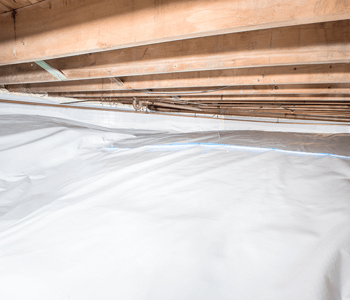
Your floors are cold but the last time you checked, the floor joists above the crawl space were stuffed with batts of fluffy insulation. What gives?
Homeowners whose homes are built over crawl spaces may wonder about this. Or they may simply turn up the thermostat and resign themselves to higher utility bills. Regardless, it's not really a mystery if you understand why a crawl space insulated with fiberglass is a really batty idea.
First consider that most crawl spaces are not sealed. Warm humid air in summer can easily find its way through vents, ill-fitting hatchways, and the small gaps in the framing that rests atop foundation walls. As this moisture-laden air cools and reaches its dew point, condensation quickly forms on cool crawl space surfaces - including the aforementioned insulation. Moisture adds weight to the fiberglass batts, which sag, becomes dislodged, and loose their effectiveness. Gaps open up that lead directly to the subfloor above.
To compound the problem, fiberglass insulation itself is not an effective air barrier. Air can pass right through it (unlike some other forms of insulation). You can see this for yourself by examining fiberglass insulation that has been in place for several years. The fibers are often discolored and loaded with dust and dirt. In effect, the batt has functioned more like a filter than a barrier. With cold air being able to reach the floor, it's no wonder that the floors get cold.
The most effective way to warm up your floors would be to use an insulation that both seals and insulates the underside of your subflooring. Spray foam or the installation of rigid foam board panels caulked at the edges, would perform very well in theory. Unfortunately, the joist bays overhead in a crawl space typically host all sorts of things you'll eventually need access to, including plumbing valves, ducts, and electric junctions. Besides, insulating just the floor will not solve a crawl space's moisture problem. The crawl space will continue to be a damp, wet place that's conducive to rot, rust, and insect infestation. Ducts will still have to travel through a cold space, loosing some the heat they are supposed to deliver to your living space. Plumbing pipes will still be susceptible to freezing.
The better way
Sealing or "encapsulating" your crawl space involves more material and effort but is a much better solution than trying to insulate under flooring. It typically includes the installation of a tough polyethylene membrane (not unlike a pool liner) over crawl space walls and floor. Seams are sealed with special tapes. Exterior vent covers are used to seal any existing vents. The hatchways may be weatherstripped or fitted with an airtight entry system. Gaps found along the rim joists (the perimeter framing that supports your exterior house walls) are also carefully sealed. In cold climates, rigid board insulation may be used on crawl space walls in combination with the liner, and a flexible insulating mat may be laid under the liner.
Once encapsulated, your crawl space becomes part of the "conditioned" (heated and cooled) portion of your home. Its temperature becomes similar to the rooms above, and your floors stay warm in winter. As a bonus, heating ducts lose less heat, interior relative humidity is controlled in summer, and pipes no longer freeze.
Getting the job done right
Sealing a crawl space is not a complex job (in fact it can be done in a few days), but it is one that must be done right. Otherwise, it can cause more problems than it solves. If you have a water infiltration problem, for example, it needs to be taken care of before the encapsulation work begins. If the waterproofing requires a sump pump, the basin will need to be carefully fitted to the liner and covered with an airtight lid. Other little details, such as water alarms and transparent sections so inspectors can check for insect activity must also be taken into account.
So, tear out that old soggy fiberglass insulation and seal your crawl space. In addition to warmer toes this winter, an encapsulated crawl space will reduce excessive moisture levels and improve the energy efficiency of your home. Be sure to contact a crawl space specialist when you're ready to do the job.
Article originally published on MyHomeScience.com



